iPhone 5S vs Galaxy S4
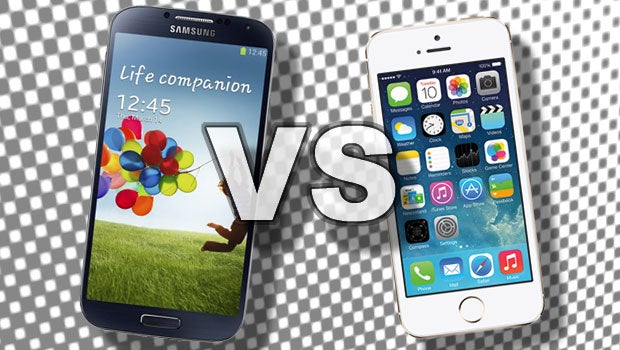
The iPhone 5S is Apple’s newfor 2013. It looks a lot like the iPhone 5, but there’s a lot of new stuff going on under the shell – and a bit on its surface too. It’s a great phone, but is it the best phone out there?
The Samsung Galaxy S4 is perhaps the iPhone 5S’s biggest rival. We’ve compared the two mobiles to see if the iPhone really is the new smartphone king.
iPhone 5S vs Galaxy S4 – Reception and Problems
The Samsung Galaxy S4 and iPhone 5S were almost unanimously praised on release. Naturally, we think you don’t need much more than the TrustedReviews verdict – we gave both phones our Recommended award. However, other tech magazines and websites agreed this time around.
It’s a little too early to judge on the public perception of the iPhone 5S, which can be judged by looking at the return rates of phones.
So far, the iPhone 5S hasn’t come into any major problems. With largely the same hardware design as the iPhone 5, Apple was working with familiar tools, and even the new hardware feature – the Touch ID sensor – hasn’t been plagued by any stories of high failure rates.
The Samsung Galaxy S4 has experienced a few problems. Its battery has been the biggest issue. There have been reports of batteries draining down very quickly, and even of them swelling up. Samsung has responded (always a sign that an issue is serious) by offering battery replacements to any owners of Galaxy S4s affected by the problem.
Samsung says the issue has “affected a limited number of customers”, and as the battery is easily removable, slotting in a new one takes all of about three seconds. There doesn’t appear to be a particular safety issue here – although there are reports of Galaxy S4s being a fire risk, this is when used with unofficial batteries and/or chargers.
Read more about Samsung Galaxy S4 problems
![]()
iPhone 5S vs Galaxy S4 – Video
iPhone 5S vs Galaxy S4 – Release Date and Price
iPhone 5S – 20 September UK release, starts at £549.99 SIM-free
Galaxy S4 – April 2013 UK release, now starts at around £420 SIM-free
The Galaxy S4 arrived quite a long time before the iPhone 5S – almost six months earlier. That’s a long time in the tech world.
It has given the iPhone series a bit of time to catch up with Samsung’s Android-powered Galaxy range, but has also let the Galaxy S4’s price slip down to a far more attractive level than it was at release. Back in the day, the Galaxy S4 cost around £600 SIM-free. Nowadays, you can get one for around £420.
The iPhone 5S costs £549.99 SIM-free, and you can bet that figure will barely drop until the next iPhone release next year. Although they’ll be thought of as heated rivals, the Samsung phone it a good deal cheaper outside of a contract.
![]()
![]()
iPhone 5S vs Galaxy S4 – Design
iPhone 5S – Aluminium frame, glass inlays,
Galaxy S4 – Plastic rear (removable)
Apple hasn’t changed the design of the iPhone much in the 2013 iPhone 5S. It’s a light, largely metal-bodied phone that feels almost unnervingly light. And put next to the plastic Galaxy S4, it appears almost comically small.
If you have tiny hands or teeny pockets, the iPhone 5S is going to pose far fewer problems, size-wise. The Galaxy S4 is 70mm wide, where the iPhone 5S is 59mm wide. If you’re used to the larger phones that have started appearing over the last year, you shouldn’t have any problems. But it is certainly a handful.
However, the Galaxy S4 is the curvier, smoother phone. The iPhone 5S has relatively severe edges, giving it a more angular feel in-hand. 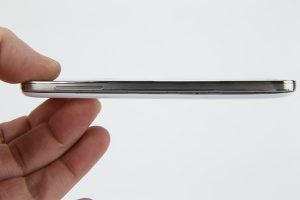
The iPhone 5S feels like the more carefully engineered phone in person, but there are advantages to the plastic design of the Galaxy S4. Its rear is removable, giving you easy access to the battery. Few people take around spare batteries with them, but it also makes replacing the battery much easier, should it fail.
You also get a microSD memory card slot, missing from the iPhone 5S.
The iPhone 5S has a feature we’ve not seen in a phone before. The Home button also acts as a fingerprint sensor that scans a digit as a means of identification. It’ll unlock the phone and let you avoid having to type in your iTunes password. Handy. The closest thing the Galaxy S4 has to this is face detection. But it’s pretty rubbish.
![]()
![]()
Spotlight on Tech – Touch ID Sensor vs Face Detection
But how does the Touch ID sensor work? It’s quite different to what you might expect.
Rather than scanning a visual map of you thumb, the iPhone 5S’s Touch ID sensor scans the conductive properties of your thumb or finger. It’s the same sort of sensory tech that lets an iPhone’s touchscreen sense the presence of your finger.
The sensor is just 170 microns thick and scans your finger at a resolution of 500dpi. In our experience, it’s fantastic. It’s sensitive enough to reliably differentiate between people accurately, and is super-quick. It’ll unlock your phone in a flash. It’s probably the most innovative part of the phone too – at least given how much it alters the way the phone is used. 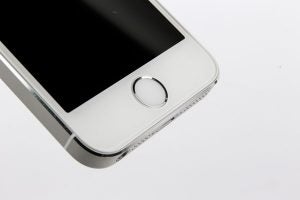
The only issue is that it can’t do much. Apple has said the Touch ID sensor will never be available to third-party apps, limiting it to system-level things like unlocking your phone. In the future we expect it to be able to route you through to different user profiles. But at present it just unlocks the phone.
Let’s take a look at the Galaxy S4’s closest alternative – Face Unlock.
It’s simpler, it’s less clever and it’s much less secure. It scans for faces using the front camera. The Galaxy S4 has a fairly good front camera, meaning it can find faces fairly reliably, but the phone can easily be unlocked using a photo of the owner, or by someone that looks similar.
Face Unlock judges who a person is based on their facial geometry – primarily the positioning of their eyes and mouth. It’s by no means secure, and it also feels much wonkier in use than the Touch ID sensor.
It’s a pretty good indication of Apple’s and Samsung’s approach to tech. Where the iPhone 5S’s Touch ID is virtually ‘invisible’ – you can forget the tech processes going on behind the scenes – the Galaxy S4’s Face Unlock makes what’s going on very obvious. You even have to correctly position your face for it to work.
![]()
![]()
iPhone 5S vs Galaxy S4 – Screen
iPhone 5S – 4-inch 1136 x 640 pixel IPS
Galaxy S4 – 5-inch 1080p Super AMOLED
As with the bodywork, Apple hasn’t messed with the core screen specs too much in the iPhone 5S. It uses a 4-inch 1,136 x 640 pixel screen – the same ‘Retina’ pixel density that caused this term to first be used back when the iPhone 4 was released in 2010. It’s a very similar panel to the one used in the iPhone 5.
The Samsung Galaxy S4 actually has higher pixel density despite using a much larger display. It has a 5-inch 1080p-resolution screen. It’s big, it’s sharp, it’s very impressive. 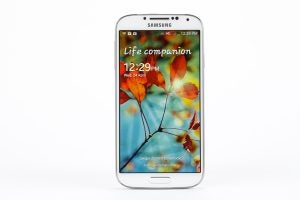
In actual use, we find the larger screen of the Galaxy S4 much better
for watching movies and TV episodes on than an iPhone 5S-size screen.
And it’s also superior for playing games, giving your thumbs extra room
to work with.
The screen technologies these phones use are completely differnet. The iPhone 5S has an IPS display, the Galaxy S4 a Super AMOLED screen.
They’re excellent examples of both screen types, but they still suffer from some characteristics associated with these kinds of panels. Top brightness is a bit better in the iPhone 5S, but contrast and black depth are better in the Galaxy S4.
Unlike some AMOLED screens, top brightness is commendable though. It has a much brighter screen than the relatively dim Galaxy S3.
Both of these are high-quality displays that are hard to fault technically – AMOLEDs tend to oversaturate colours, but the Galaxy S4 packs in colour temperature customisation options to help you fix this.
As these are such fantastic performers all-round, the main thing to consider is whether you really want a giant screen, or would prefer a smaller, more pocket-friendly mobile. But for the sake of this comparison, we’ll hand the win to Samsung.
![]()
![]()
iPhone 5S vs Galaxy S4 – Storage
iPhone 5S – 16/32/64GB non-expandable
Galaxy S4 – 16/32GB, microSD (64GB in some countries)
The Samsung and Apple appropaches to storage are pretty different. Samsung always tries to make it easy to let you add extra storage, by including a memory card slot.
The Samsung Galaxy S4’s microSD slot lives under the phone’s removable plastic battery cover. Samsung makes 16GB, 32GB and 64GB versions of the S4, but you’ll only find the 16GB and 32GB editions in the UK. The 16GB edition is by far the most common.
It’s easy to get your hands on each of the three storage iterations of the iPhone 5S (aside from intermittent stock shortages) – 16GB, 32GB and 64GB. It’s partly because you can get them directly from Apple, and partly because the lack of a memory card slot necessitates higher-capacity options. We had hoped to see Apple introduce a 128GB iPhone, but there is no 128GB iPhone 5S. Yet.
Apple has never included ways to increase storage in its mobile devices with a memory card slot. And that’s not going to change any time soon.
![]()
![]()
iPhone 5S vs Galaxy S4 – Software
iPhone 5S – iOS 7
Galaxy S4 – Android 4.2 with TouchWiz interface
The iPhone 5S was the first device to launch with iOS 7, arguably the biggest change in the iOS platform since the system was launched in 2007. 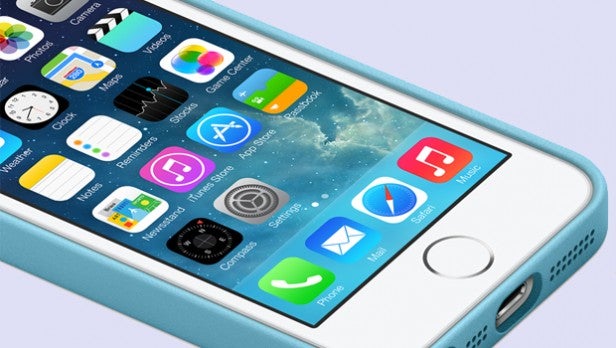
It’s a visual and functional reworking of the software. Jonny Ive was the man behind the re-vamp – he was part of the team that designed the iPod, the iMac, the iPhone and more.
At the other end of the ring, the Galaxy S4 uses Android 4.2 Jelly Bean with the TouchWiz interface plastered on top.
Their visual styles are quite different. Where iOS 7 tries its best to look sharp and stylish, TouchWiz makes do with ‘happy’ and ‘colourful’. It’s not the coolest Android interface we’ve seen. It cares much more about adding features.
TouchWiz adds a crazy amount of features to Android – some of which have encouraged Google to add features to Android itself in the past.
Good additions include gesture typing, a power management mode, enhanced notifications bar and sine decent custom widgets. There are loads of slightly wonky and superfluous extras too, though. Like Air Gesture and Air View.
For more read our top 10 new TouchWiz features article
Although it has traditionally kept things very simple, iOS adds some extra features bulk with iOS 7. It has power management options in its drop-down notifications bar, the camera app has gotten a lot richer. It also offers new productivity apps including Keynote.
For more, head to our iOS 7 tips and tricks guide.![]()
![]()
iPhone 5S vs Galaxy S4 – CPU and RAM
iPhone 5S – Apple A7 dual-core 64-bit chip, 1GB RAM
Galaxy S4 – Snapdragon 600 1.9GHz Quad-core, 2GB RAM, Adreno 320 GPU
Released almost six months after the Galaxy S4, you’d hope that the iPhone 5S would be clearly more powerful than the Samsung phone. And it is. However, it doesn’t sound that way from the numbers alone.
The Samsung Galaxy S4 has a Snapdragon 600 1.9GHz quad-core processor, the iPhone 5S a dual-core A7 chip. The S4 also has more RAM – 2GB against 1GB.
The Galaxy S4 sounds more powerful, but it is not. Benchmarks show that the iPhone 5S is a significantly more powerful phone, and it’s also the first 64-bit phone produced.
Here’s a run-down of how they perform in benchmarks, relatively.
Sunspider (lower is better)
Galaxy S4 – 1100ms
iPhone 5S – 410ms
Peacekeeper (higher is better)
Galaxy S4 – 450
iPhone 5S – 1732
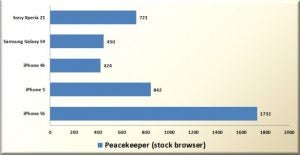
Geekbench (higher is better)
Galaxy S4 – 1620
iPhone 5S – 2553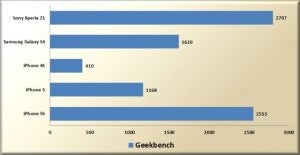
3DMark Icestorm unlimited (higher is better)
Galaxy S4 – 10379
iPhone 5S – 13995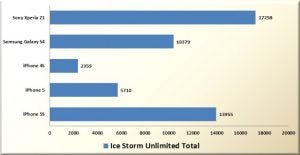
The iPhone 5S’s Apple A7 processor is fantastic, especially given it’s ‘just’ a dual-core chip. However, it will take a while to see the benefits of its 64-bit architecture.
The iPhone 5S also has a separate motion sensor chip, which monitors the gyroscope, compass and accelerometer. It’s called the M7, and we imagine it’s there to increase battery efficiency for fitness apps that need the read-outs from these sensors.
The iPhone 5S will also triumph in terms of the software that will actually make use of that power. Although it’ll take devs a little time to get their heads around the hardware (think weeks, not months), the iPhone 5S will have many more impressive games.
![]()
![]()
iPhone 5S vs Galaxy S4 – Camera
iPhone 5S – 8-megapixel cameras with LED flash
Galaxy S4 – 13-megapixel camera with LED flash
In a surprise move, Apple has not changed the camera resolution of the iPhone series with the 5S. Like the iPhone 4S and iPhone 5, it has an 8-megapixel sensor.
However, it’s a good deal better. It’s 15 per cent larger, resulting in larger sensor pixel size. Larger sensor pixels means better low light performance and – generally – better image quality.
The iPhone 5S has pixels of 1.5 microns, where the higher-resolution Galaxy S4 has smaller 1.1 micron pixels. Judging by our previous photo comparison of the iPhone 5 and Galaxy S4, in 100 per cent optimal conditions the Samsung phone should be able to capture more detail. Let’s see if it actually does.


![]()
The iPhone 5S’s photo is more lively a bright than the Galaxy S4’s. There are some areas of overexposure, though – where details in brighter/whiter are blown out because of over-keen exposure compensation.
Fine detail capture is superior in the Galaxy S4 – check out how much clearer the lines between the windows are, in the building in fron of the Gherkin. The files are also simply bigger – the comparison crop-out shows the actual pixels of the photos. 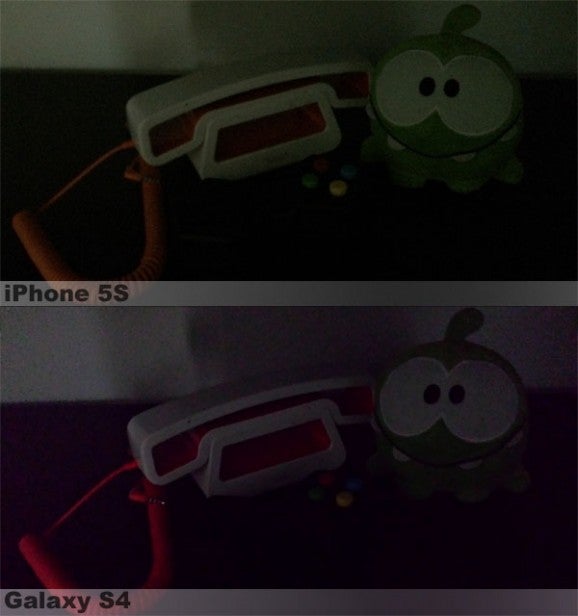
Low-light performance is marginally better in the iPhone 5S. Our standard low-light test shows that both phones are pretty rubbish when lighting conditions are very poor. The iPhone 5S’s shot is a little less noisy, although colour accuracy is better in the Galaxy S4.
The camera apps of the Galaxy S4 and iPhone 5S are quite different in their approaches.
iOS 7 adds a bunch of features to the iPhone 5S camera, but it’s still very simple to use. You just choose your aspect ratio, whether to use HDR and whether to use an arty filter or not. There are no scene modes to worry about – the app does all that for you.
The Galaxy S4 is way more feature-packed. There are more than 10 modes, most of which use pretty invasive photo effects, including those that merge multiple exposures.
You can do a whole lot more with the Galaxy S4, but we tend to find the iPhone 5S a more satisfying everyday shooter. It’s a slightly faster photographic performer, and with the Galaxy S4 you need to manually switch to Night mode to get the best results in poor lighting.
HDR
One of the most useful extra modes common in smartphones is HDR. this merged multiple exposures to improve photo performance in tricky lighting conditions. It’s a great way to mitigate the technical limitations of a phone camera. Here’s the Galaxy S4 and iPhone 5S modes in action.

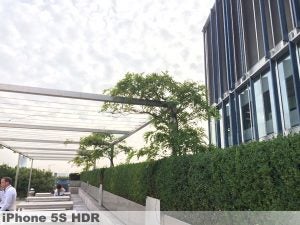
As we saw in the landscape shot, the iPhone 5S’s shot is brighter, but the exposure is actually better in the Samsung photo. HDR mode is also better in the Samsung phone. Check out the tiny crane in the far background. It’s clearer in the Galaxy S4 pic thanks to the lesser-exposed sky, and the undulation of the clouds is much clearer too. Nice work, Samsung.
![]()
![]()
Verdict
In terms of pure specs, the iPhone 5S doesn’t appear to have a huge upper hand over the Samsung Galaxy S4. However, look very close indeed and you’ll see where those extra months of progress have gone. The various tech tweaks and the more efficient CPU make the 5S the most technologically impressive phone.
Next, read our comparison iPhone 5 vs Galaxy S4


